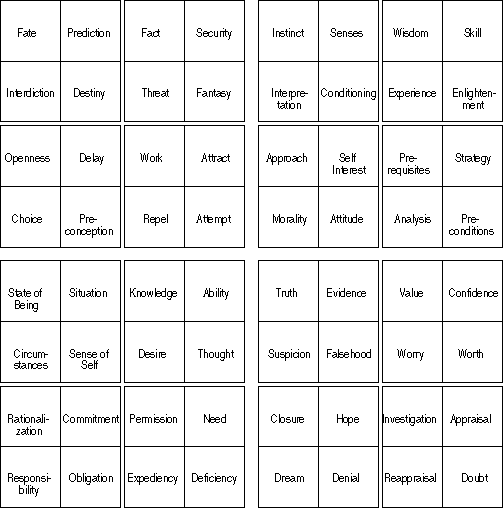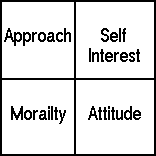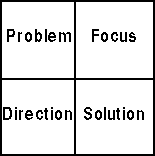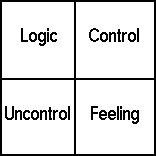Chapter 25
Storytelling
&
Thematic Appreciations
Selecting Thematic Appreciations
Selecting a Range
A Range is the thematic focus of a throughline. The focus, when explored with its
counterpoint and then coupled with a conclusion, creates a premise. A throughline's
Range is found at the Variation level of the thematic structure. Variations, as part of
the balanced structure, do not provide value judgments to thematic foci as to whether they
are good, bad or indifferent. These interpretations are deciphered by the audience from
the interaction of all the dynamics of a story. For example, whether or not the
Main Character succeeds or fails can have a big influence on the value of a thematic
focus, even though success and failure are not Variations.
Focus and Point of View
An author might select the Variation "Morality" as the thematic focus, making
the thematic conflict Morality vs. Self-Interest. But which is better between the two?
Both are. And both are worse. It really depends on the context. The author's message might
be to speak out in favor of putting others first, or that one must first take care of
oneself before one can help others. Either point of view can be argued, as long as it is
argued completely and makes sense in context.
Because it is simply the point of focus, one might argue for a Range of Morality by either
showing that Morality is a good thing or that Self-interest is bad. Of course, both
Variations will take their turn at the forefront in the exploration of the pair, yet one
will seem to be the pivot point around which the throughline revolves. Is the
throughline's message about Morality or about Self-Interest? The answer to
that question determines the thematic Range.
Thematic Quads
Although the exploration of a thematic focus will develop nuance and detail, the focus
itself (as well as the thematic counterpoint) must be pure so the issues at stake are
clear. This provides a balanced, delineated argument at the heart of the thematic
exploration, much as there must be a clear storyform at the heart of the storytelling. To
accommodate this need for clarity, one must zero in on the specific Range at the heart of
a throughline's argument. With so much balance involved, choosing the right one for your
story is not always an easy thing to do. There is a method one can apply, however, that
makes it a bit easier and even rather fun.
As described earlier in the section on Theme, there are 64 Variations, grouped into four
sets of 16. Each set has four quads as illustrated below. We can start by selecting a set,
then a quad, then a conflict and finally a Range, similar to the manner in which we
originally explored the thematic structure by starting with the broad stroke Classes and
then sub-dividing each into Types, then Variations, and finally Elements.
Dramatica's 64 Thematic Variatio
Universe Variations -------------------Physics
Variations

Psychology Variations
---------------------------------------Mind Variations

Perhaps the easiest way to get a feel for one's theme is to take each quad by
itself, and experience the four Variations all at once to get a sense of the relationships
between them. In the Morality/Self-Interest quad, for example, the other two Variations
are Approach and Attitude. It is the nature of these Variations that the good or bad
nature of one pair will be measured by the other pair. In this case, if either
Morality or Self-Interest was selected as the focus, the contrast between them would be
measured in terms of Attitude and Approach. If Attitude and Approach were to be explored,
they would be measured by Morality and Self-Interest.
Grazing for Themes
Let's assume you have not yet selected any other appreciations. Begin by picking the
throughline you want to work with, i.e., Objective Story, Main Character, etc. Don't
consider what Class that throughline might be attached to. Then, keeping that throughline
in your mind, get a feel for the Variations in each Class by simply letting your eyes
wander over each set of sixteen and treating them as a single item. Eventually one set
should emerge as having the best overall feel for that throughline. In other words, the
Variations in that set best express the kinds of thematic issues you will want to explore
in that throughline.
Now, think of the sixteen Variations in that set as four groups of four. Each group is
called a quad, and has a unique flavor that defines the four Variations in it as
being part of the same family. Consider all four quads in the set, getting a feel for each
one. Then zero in on the quad that best exemplifies the family of subject matter you wish
to address in that throughline.
In the quad you have selected there are two different diagonal pairs of Variations. Pick
the diagonal pair (dynamic pair) of Variations that illustrates the thematic conflict you
wish to explore. Finally, choose one of the two Variations in the pair to be the focus of
your theme, and you have your Range. The other Variation in the pair is your thematic
counterpoint.
In this manner, you can begin with a feeling and end up with a specific dramatic choice
that will affect not only theme, but character and plot as well.
Selecting Character Appreciations
A Bridge between Subjective and Objective...
What is so special about the Main Character? The Main Character is uniquely qualified
to illustrate both the Objective and Subjective problems. This is because he contains the
one character Element that is central to both the Objective and Subjective problems. As a
result, neither problem can be resolved without his participation. Therefore, selecting
the Main Character's Problem requires the consideration of other Elements as well.
The Main Character need not be the source of the problem, but might contain the Element
crucial to the solution. This is why it is so easy to make the Protagonist the Main
Character. The Protagonist is pursuing the Objective Story goal already; why not have him
pursue the subjective one as well? If he is taking the correct approach in the author's
view, he contains the solution. If he is taking the incorrect approach, he contains the
problem. Either way, the Main Character, as Protagonist or not, is the linchpin that holds
the Objective and Subjective Stories together.
The act of pursuing a goal and being crucial to achieving it are two completely different
things. For example, it might be the Main Character's insight or resolve that spurs the
Protagonist on to success or distracts it into failure. Either way, the Main Character precipitates
the outcome of the story by changing or by remaining steadfast in regard to that crucial
Element.
The Problem Quad

In the quad of Elements containing the Problem Element, there is also its counterpart,
the Solution Element, which is indeed the solution to that particular problem. There are
also two remaining Elements in the quad: the Focus and the Direction. If the Problem is a
disease and the Solution the cure, then the Focus is the primary symptom of the story's
problem and the Direction is that symptom's most appropriate treatment.
As indicated, Main Characters do not have to contain the Element that is the cause of the
problem. But if they do not contain the Problem Element, they will contain one of the
other Elements in this crucial quad.

For example, we might determine that we want the problem and solution to be found in
the quad containing Logic, Feeling, Control and Uncontrolled. Any one of these can be the
problem. If we select Feeling as the problem, then Logic will be the solution. If we
select Control as the problem, then Uncontrolled will be the solution. Once we determine
one pair to be the Problem-Solution pair, the other pair is the Focus-Direction pair.
Focus is simply descriptive of what the Main Character believes the problem to be;
Direction is what they feel the solution is. So, for every actual Problem and Solution,
there is a corresponding Focus and Direction. Which Element is focus and which is
direction is determined by other dynamics at work in the story.
Change Characters and the Crucial Element
In the case of a Change Main Character, he will either contain the Problem or
Solution Element. In the case of a Steadfast Main Character, he will either contain
the Focus or the Direction Element.
Why would a Change Main Character contain the problem or solution? In a sense, the
inequity of the story is not just in the Main Character or in their environment, but
exists between the two. It is created out of an imbalance in the distribution of Elements.
When a Main Character solves a problem by changing, he restores balance either by taking
an Element from himself and placing it back in the environment where it belongs, or by
grabbing an Element out of the environment and putting it within himself where it is
needed. If he must give up an Element, he contains the solution to the problem. If he must
receive an Element, he contains the problem. Either way, the Main Character must change
his internal make-up: his very nature.
Steadfast Characters and the Crucial Element
For a Steadfast Main Character, the imbalance is not seen by him to be between himself
and the environment, but wholly within the environment. In this case, the Main Character
takes an Element from one place and moves it to another to restore balance. If the story
is built around the Element that needs to be moved, the Main Character contains the focus.
If the story is built around the hole that needs to be filled, the Main Character contains
the direction.
The real essence of the Crucial Element is that the Main Character is responsible for
either getting rid of something undesirable or obtaining something desirable, either
within himself or in his environment. If accomplished, the Main Character restores
equilibrium and both the Objective and Subjective problems are resolved.
Wrapping Up The Selection Of Appreciations
We could write endlessly on how to evaluate each appreciation. But in truth, there is no
mechanical way to make these choices. Any choice is just as good as any other. It is only
when the author's feelings and intents come into play that one selection proves better
than another.
When previous selections have already been made, however, then the logistics of the
story's argument begin to take a degree of control. The more selections that are made, the
greater that control becomes until all remaining selections have already been
pre-determined by the author's earlier choices.
Understanding which appreciations have the greatest influence on others goes a long way to
helping an author make appropriate choices that keep his message and the feelings
generated by his story's structure consistent. Still, such considerations are intuitive in
nature, and when intuition fails, it helps to employ the model of the relationships
between appreciations contained in the Dramatica software.
Proceed
to the Next Section of the Book-->
How to Order Dramatica:
A New Theory of Story
Back to
the Table of Contents
Back to the Dramatica Home Page
Copyright 1996, Screenplay Systems, Inc.
The Dramatica theory was developed by
Melanie Anne Phillips and Chris Huntley
Chief Architect of the Dramatica software is Stephen
Greenfield
Dramatica is a registered trademark of Screenplay Systems Incorporated
Try Dramatica & StoryWeaver Risk
Free*

$179.95
$29.95
*Try either or both for 90 days. Not working for you?
Return for a full refund of your purchase price!
About Dramatica and
StoryWeaver
Hi, I'm Melanie Anne Phillips,
creator of StoryWeaver,
co-creator of Dramatica
and owner of Storymind.com. If you have a moment, I'd like to tell you
about these two story development tools - what each is designed to do, how
each works alone on a different part of story development and how they can be
used together to cover the entire process from concept to completion of your
novel or screenplay.
What They Do
Dramatica is a tool to help you
build a perfect story structure. StoryWeaver is a tool to help you build
your story's world. Dramatica focuses on the underlying logic of your
story, making sure there are no holes or inconsistencies. StoryWeaver
focuses on the creative process, boosting your inspiration and guiding it to add
depth, detail and passion to your story.
How They Do It
Dramatica has the world's only
patented interactive Story Engine™ which cross-references your answers to
questions about your dramatic intent, then finds any weaknesses in your
structure and even suggests the best ways to strengthen them.
StoryWeaver uses a revolutionary new
creative format as you follow more than 200 Story Cards™ step by step through
the story development process. You'll design the people who'll inhabit
your story's world, what happens to them, and what it all means.
How They Work
Together
By itself Dramatic appeals to
structural writers who like to work out all the details of their stories
logically before they write a word. By itself, StoryWeaver appeals to
intuitive writers who like to follow their Muse and develop their stories as
they go.
But, the finished work of a
structural writer can often lack passion, which is where StoryWeaver can help.
And the finished work of an intuitive writer can often lack direction, which is
where Dramatica can help.
So, while each kind of writer will
find one program or the other the most initially appealing, both kinds of
writers can benefit from both programs.
Try Both Programs
Risk Free!
We have a 90
Day Return Policy here at Storymind. Try either or both of these
products and if you aren't completely satisfied we'll cheerfully refund your
purchase price.
